High-Energy Neutrinos from the Cosmos
advertisement
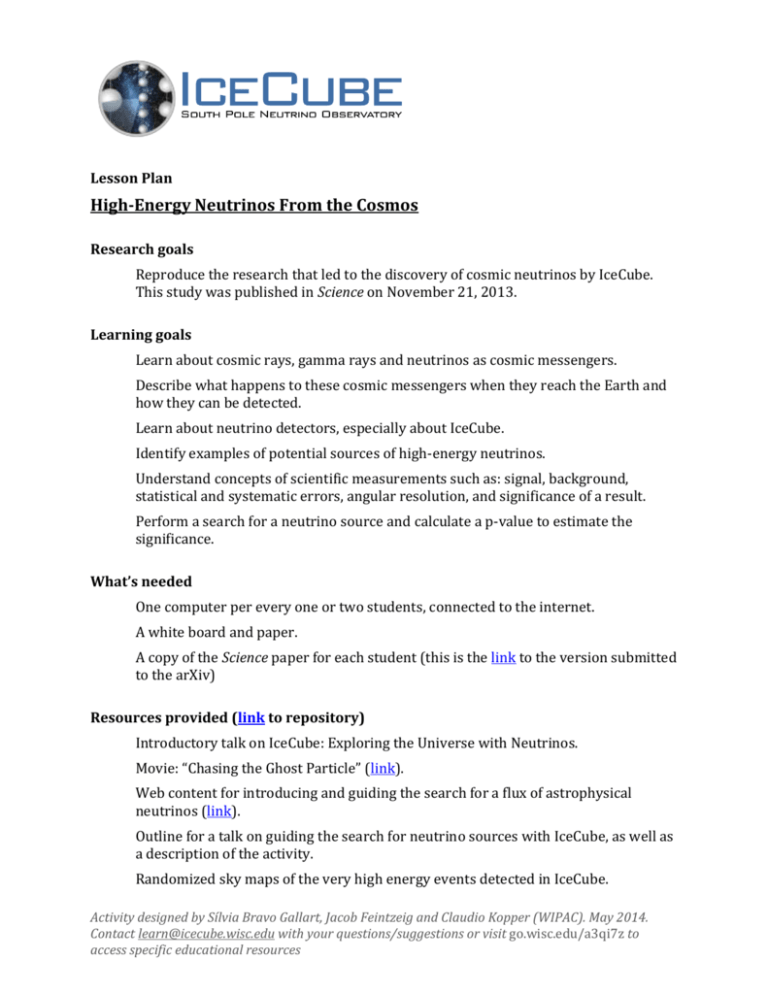
Lesson Plan High-Energy Neutrinos From the Cosmos Research goals Reproduce the research that led to the discovery of cosmic neutrinos by IceCube. This study was published in Science on November 21, 2013. Learning goals Learn about cosmic rays, gamma rays and neutrinos as cosmic messengers. Describe what happens to these cosmic messengers when they reach the Earth and how they can be detected. Learn about neutrino detectors, especially about IceCube. Identify examples of potential sources of high-energy neutrinos. Understand concepts of scientific measurements such as: signal, background, statistical and systematic errors, angular resolution, and significance of a result. Perform a search for a neutrino source and calculate a p-value to estimate the significance. What’s needed One computer per every one or two students, connected to the internet. A white board and paper. A copy of the Science paper for each student (this is the link to the version submitted to the arXiv) Resources provided (link to repository) Introductory talk on IceCube: Exploring the Universe with Neutrinos. Movie: “Chasing the Ghost Particle” (link). Web content for introducing and guiding the search for a flux of astrophysical neutrinos (link). Outline for a talk on guiding the search for neutrino sources with IceCube, as well as a description of the activity. Randomized sky maps of the very high energy events detected in IceCube. Activity designed by Sílvia Bravo Gallart, Jacob Feintzeig and Claudio Kopper (WIPAC). May 2014. Contact learn@icecube.wisc.edu with your questions/suggestions or visit go.wisc.edu/a3qi7z to access specific educational resources Activity overview This is an analysis to search for a flux of astrophysical neutrinos in IceCube data. Exercises and discussions grow in complexity while addressing the main ideas of the research. The activity is designed in five parts. We recommend covering at least four parts: i, ii, iii and then iv or v. Going through the five parts, with the proper guidance from teachers, should not take more than six hours. Activity outline: i) Introduction to IceCube ii) Introductory talk to explain the analysis goals and tools. iii) Qualitative analysis to understand the signal we are looking for. iv) Significance of the flux of very high energy events detected in IceCube. v) Search for a neutrino source with IceCube. i) Introduction to IceCube We suggest at least one of the following resources: an introductory talk on IceCube and watching the movie “Chasing the Ghost Particle.” The introductory talk can be given either by an IceCube researcher through Skype or by the teacher using the talk outline “Exploring the Universe with Neutrinos.” Each of these activities will last for about 30 minutes. ii) Introduction to the analysis We suggest following the guided activity in the Analysis section of the IceCube Masterclass website. iii) Qualitative analysis: understanding the nature of our signal and background Teachers will guide students in a discussion about which particles can be detected by IceCube. They can use information on the masterclass website: “The Detection of Neutrinos in IceCube.” Students should identify what signal we are looking for (a flux of astrophysical neutrinos) and what our background is (muons and neutrinos produced by the interaction of cosmic rays with the Earth’s atmosphere). Activity designed by Sílvia Bravo Gallart, Jacob Feintzeig and Claudio Kopper (WIPAC). May 2014. Contact learn@icecube.wisc.edu with your questions/suggestions or visit go.wisc.edu/a3qi7z to access specific educational resources Then students will be asked to identify different types of events/detected particles using the online IceCube Particle ID Quiz. Students will discuss how signal and background are similar/different and identify the properties that allow us to distinguish between them. o For signal: We expect there to be a 1:1:1 ratio of the three type of neutrinos (electron, muon and tau neutrinos). For this reason, we expect to have more cascade-like events than track-like events. Astrophysical neutrinos will have higher energies and they will be abundant in the southern sky. This is due to the absorption of high-energy neutrinos in the Earth. Neutrinos have a higher probability of interacting with the Earth, while passing through it, as their energy level increases. o For background: Most events will be track-like since they will be due to cosmic ray muons and atmospheric νμ. The energy range should be lower than for cosmic neutrinos. Cosmic-ray muons will only be produced in the southern sky, since muons will be absorbed by the Earth when they penetrate it. To help students guess some of the signal-vs.-background properties, students will discuss as a group the differences in the displays from a set of simulated signal and background events (Particle ID Quiz, background_signal). Teachers will guide students in designing an event selection for this analysis, i.e., looking at how we can select a good fraction of the astrophysical neutrinos while keeping our background low. o We can design two main selections: looking only at muon tracks coming from the Northern Hemisphere or selecting only events that start inside the detector. In both cases, we will introduce an energy cut since we know that our signal will be more abundant at higher energies. Selection 1: A muon track in IceCube can be produced by a muon that is generated by the interaction of cosmic rays in IceCube or by a muon neutrino interacting in or around the detector. However, muons will be absorbed (i.e., will interact) after traveling a few kilometers in the Earth. For this reason, we know that any muons coming from the Northern Hemisphere must have been produced by a muon neutrino. Still, this neutrino could be atmospheric— again, produced by the interaction of cosmic rays with the atmosphere—or astrophysical. Selection 2: Any event seen in IceCube should be either a muon created by a cosmic ray or by a neutrino interacting in or around the detector. Muons entering the detector will already be producing Cherenkov light since they are charged particles. They could have been created by cosmic rays interacting with the atmosphere or by a neutrino interacting outside the detector. Activity designed by Sílvia Bravo Gallart, Jacob Feintzeig and Claudio Kopper (WIPAC). May 2014. Contact learn@icecube.wisc.edu with your questions/suggestions or visit go.wisc.edu/a3qi7z to access specific educational resources However, any event that starts inside our detector (i.e., that the first light is produced inside the detector) has to be a neutrino. o Teachers will explain that the second selection was the one used by IceCube for this analysis and will guide students to design a veto-like selection. See image below. Apart from vetoing events that start in the outer sensors, IceCube also vetoes events that start in the grey region displayed in the image. This is a dust layer, with dust from a few thousand years ago. Students can try to see how this veto works with the training Particle ID quiz, Selecting neutrinos in IceCube: the veto approach. Students should also come to the idea that we are expecting only a few events. iv) Significance of the flux of very high energy events detected in IceCube Teachers will present the display of the 28 very high energy events that passed the veto selection when analyzing two years of IceCube data. Students will be given two minutes to guess which are the ones with the highest energy (using the Particle ID Quiz, hese_all). Teachers can spend a few minutes going through each of the 28 events, explaining why some of them are especially interesting (like tracks that point to sources, the highest Activity designed by Sílvia Bravo Gallart, Jacob Feintzeig and Claudio Kopper (WIPAC). May 2014. Contact learn@icecube.wisc.edu with your questions/suggestions or visit go.wisc.edu/a3qi7z to access specific educational resources energy ones because they are most probably signal, …) or just explaining singularities of the data (such as why we use time in Julian date, why declination and right ascension, …). Use Particle ID Quiz, hese. Teachers will provide the students with a table of properties of the 28 events (included in the paper) and will guide an initial discussion about which of the properties can be easily identified as “signal-like.” At this point, we would like the students to focus on three properties: number of showers or cascade-like events, declination or if they are coming from the Northern of the Southern Hemisphere, and high-energy events. Students could reproduce some of the images in the paper, such as the one in the image below. Teachers will guide students to think about how we can estimate the significance of this signal. We see more cascade-like events, and more events coming from the Southern Hemisphere, as expected. But is this significant? How sure are we that these are astrophysical neutrinos? We would like students to think about the relation between theory and experiments, that is, between what we expect and what we observe. We can also show how we try to prove that this data is significantly different from background. The idea is simple: we count how many events we observe for a given energy/declination and we compare these numbers to what we expect from a background-only hypothesis. Activity designed by Sílvia Bravo Gallart, Jacob Feintzeig and Claudio Kopper (WIPAC). May 2014. Contact learn@icecube.wisc.edu with your questions/suggestions or visit go.wisc.edu/a3qi7z to access specific educational resources This is what IceCube did. However, the significance of our results is very sensitive to our event selection, i.e., to the signal-vs.-background ratio. To discuss that, students can play with the energy cut and see how the zenith distribution changes (link). Teachers will show a comparison of theoretical estimates for signal and background, explaining how the significance can be calculated. They can use images from the paper or the images below. They will guide students to the idea of binned distributions and to the importance of choosing the correct range and binning for each property. Activity designed by Sílvia Bravo Gallart, Jacob Feintzeig and Claudio Kopper (WIPAC). May 2014. Contact learn@icecube.wisc.edu with your questions/suggestions or visit go.wisc.edu/a3qi7z to access specific educational resources v) Quantitative analysis: search for point sources See activity description and guided talk “Search for neutrino sources with IceCube” (link). Activity designed by Sílvia Bravo Gallart, Jacob Feintzeig and Claudio Kopper (WIPAC). May 2014. Contact learn@icecube.wisc.edu with your questions/suggestions or visit go.wisc.edu/a3qi7z to access specific educational resources
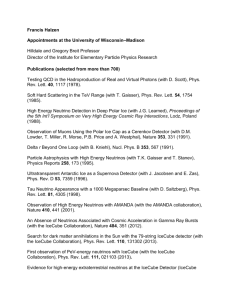
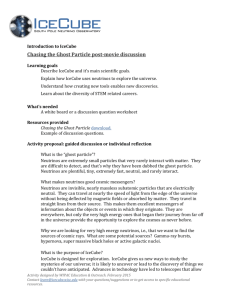

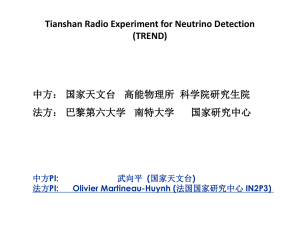
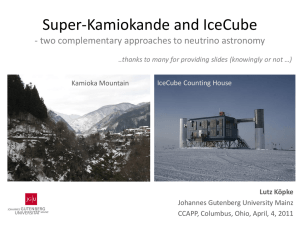
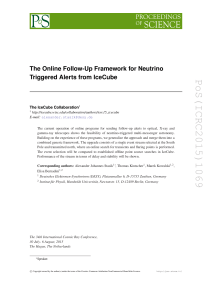
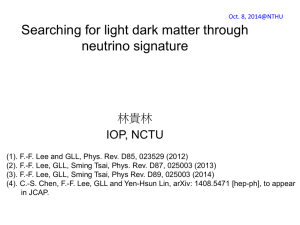
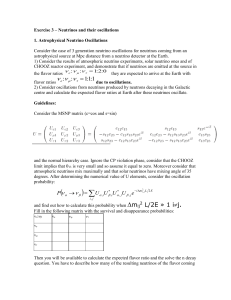
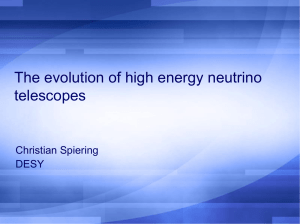
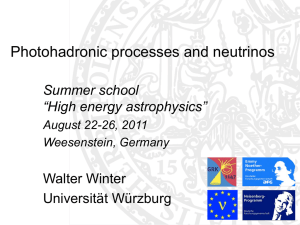
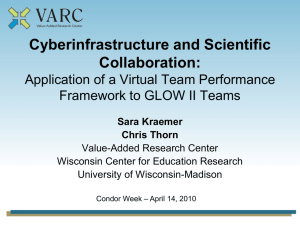
![slides [ppt] - Latsis Symposium 2013](http://s2.studylib.net/store/data/005775657_1-59a6bcb8e3e83e4e7dc3b73bb4fc9b7e-300x300.png)